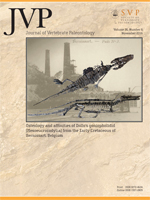A petrosal bone from the French Middle Miocene locality Sansan is described. It belongs to the tragulid species Dorcatherium crassum. Using high-resolution X-ray computed tomography, we scanned this petrosal bone and segmented its embedded bony labyrinth. We compared the morphological data with those of three living Tragulidae: Tragulus javanicus, Hyemoschus aquaticus, and Moschiola meminna. We ran a phylogenetic analysis where fossil and extant pecoran ruminants were included to understand the distribution of characters of the petrosal bone and bony labyrinth within ruminants. We propose a set of new synapomorphies for the Tragulidae among the Ruminantia, including the absence of the basicapsular groove, a knob-shaped mastoid region, a knob anterior to the subarcuate fossa on the petrosal bone, a high number of cochlea turns, the dorsal insertion of the posterior limb of the lateral semicircular canal, the extension of the lateral semicircular canal beyond the plane of the posterior semicircular canal in dorsal view, and a pouch-like endolymphatic sac on the bony labyrinth. The clade constituted by Tragulus and Moschiola is confirmed by new synapomorphies such as a double convexity of the promontorium and a large pouch-like endolymphatic sac that covers the common crus. We demonstrate the potential of characters of the bony labyrinth for the phylogeny of ruminants.
How to translate text using browser tools
1 November 2016
A Dorcatherium (Mammalia, Ruminantia, Middle Miocene) Petrosal Bone and the Tragulid Ear Region
Bastien Mennecart,
Loïc Costeur
ACCESS THE FULL ARTICLE





